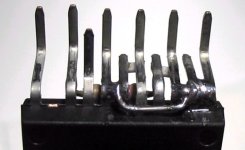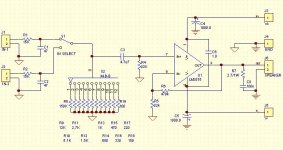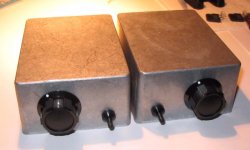Hi Analog SA,
Well, I have bought the Counterpoint because it was cheap ($200u.s.) and it would allow me to use it with my Gaincard experiment when I use it (power amp) and eventually, I'll use its phono stage when I bring my Mission turntable back to life...
Up to now, I've always prefered feeding my 300B amp directly from the Meridian player. Lots less parts in the signal path. I have put an entry selector and volume control on the tube amp. So, most of the time, the Counterpoint has been collecting dust. But it looks cute..
😉 and sounds good too.. when I use it, of course..
Well, I have bought the Counterpoint because it was cheap ($200u.s.) and it would allow me to use it with my Gaincard experiment when I use it (power amp) and eventually, I'll use its phono stage when I bring my Mission turntable back to life...
Up to now, I've always prefered feeding my 300B amp directly from the Meridian player. Lots less parts in the signal path. I have put an entry selector and volume control on the tube amp. So, most of the time, the Counterpoint has been collecting dust. But it looks cute..
😉 and sounds good too.. when I use it, of course..
Hi Joe Bob,
Well, about a GC gathering in Québec city, it's a great idea. I just hope I'd have more time to work on my GC project, so I can really "participate", not just wondering at your own marvels.. he he..
I live 30 mins from north/west from Qc.
Let's hope we'll have some enthusiasm about the music too.. not just the projects.. 😉
See ya'
Well, about a GC gathering in Québec city, it's a great idea. I just hope I'd have more time to work on my GC project, so I can really "participate", not just wondering at your own marvels.. he he..

I live 30 mins from north/west from Qc.
Let's hope we'll have some enthusiasm about the music too.. not just the projects.. 😉
See ya'
Whould we do that if it was inferior?
Quite possibly, yes. Yours is a commercial product and compatibilty/reliabilty issues are just as important as sonics. I really don't think an unbuffered IGC is viable commercially. What intrigues me is that you notice improvements in soundstaging, in my view the weakest point of a GC. I did't notice any improvement with it non-inverted - it still sucks. Could it be the improvements were due to component types rather than topology?
In a stereo NI amp we noticed big improvement in depth of a soundstage comparing to IGC. I also have IGC monoblocks and the soundstage is about as good with them as with NI amps. So it seems that separate PS don't restrict soundstage as much as one shared supply in an integrated amp.
When playing with components choices on a NI amp, we noticed that depending on different resistor types (same values) the soundstage was changing as well.
And I agree that soundstaging is the weakest point of NI amp. Everybody complained about it.
When playing with components choices on a NI amp, we noticed that depending on different resistor types (same values) the soundstage was changing as well.
And I agree that soundstaging is the weakest point of NI amp. Everybody complained about it.
Greg, do you have anymore pics to show? did you completely eliminate the caps in this amp? I love the idea of using the smd resistors. I NEED MORE INFO ON YOUR AMP!!!!!😀
Great work, btw, looks like a very clean job....
Great work, btw, looks like a very clean job....
JCoffey said:Greg, do you have anymore pics to show? did you completely eliminate the caps in this amp? I love the idea of using the smd resistors. I NEED MORE INFO ON YOUR AMP!!!!!😀
Great work, btw, looks like a very clean job....
Thanks,
This guy Peter, raised the standards so high and I don’t want to just shove the parts in anything that I can find. It has to look good seating on the shelf. So far I can’t find housings for the two toroid transformers and I’m stuck. I’ll show some pictures as soon as I have something ready.
That’s the sch. and I’ll be playing with the values of R5,R6. Keeping the ratio I’d like to see what the lowest values are that will give me the lowest DC offset. I may try it without C3 also but then the offset is going to be worse off. Mind you 30 mV DC over 6 Ohms is 5mA more/less imbalance of the output, so I don’t know if I should be concerned about that. It's the same as having 6k resistor from output to -V (-30V). The PS is 2 traf’s 220VA/2x22VAC and 2 bridges each. As soon as I have it working I’ll report.
Attachments
GregGC said:
Keeping the ratio I’d like to see what the lowest values are that will give me the lowest DC offset.
While there is nothing wrong with tweaking for lowest offset, you should be also aware, that changing the resistors values and adding/removing certain caps will also influence the sonic signature of the amp. Sometimes it's actually better to accept some offset, than having close to 0V at the output at the cost of compromised sonics.
Personally, I don't even care if the offset is aroun 60mV or so.
Peter,
What is your gut instict regarding surface mount resistors?
I notice that they're used in that Rowland amp and thought it
was interesting in the pictures posted in this thread by Greg.
...maybe they're only good for mass production amps built with
PCB's? they are so tiny! How can you be sure you don't burn
them up while soldering! Just wondered if you had ever
considered them.
(just another variable to throw in to the circuit!) 😉
What is your gut instict regarding surface mount resistors?
I notice that they're used in that Rowland amp and thought it
was interesting in the pictures posted in this thread by Greg.
...maybe they're only good for mass production amps built with
PCB's? they are so tiny! How can you be sure you don't burn
them up while soldering! Just wondered if you had ever
considered them.
(just another variable to throw in to the circuit!) 😉
To tell the truth, I never used them before. They seem appealing though, as one might think that their sonic signature disappears with the size, but somehow I don't think it's the case. Worth trying though. I wouldn't worry about burning them.
Hi Peter,
I have been reading about your new NIGC lately, and was wondering where you got the bronze from, and how much was it?.
The only source I have found is mcmaster, and it's really expensive there, for a hunk of bronze.
Brass is cheaper at onlinemetals, and I was thinking about trying that.
BTW, how big is the bronze?
Hope I am not repeating anything you answered before, but I did not see in anywhere.
Thanks,
Randy
I have been reading about your new NIGC lately, and was wondering where you got the bronze from, and how much was it?.
The only source I have found is mcmaster, and it's really expensive there, for a hunk of bronze.
Brass is cheaper at onlinemetals, and I was thinking about trying that.
BTW, how big is the bronze?
Hope I am not repeating anything you answered before, but I did not see in anywhere.
Thanks,
Randy
I bought the piece 12 x 2 x 0.9 from Metal Supermarkets (locally). It was about $90 CAD.
The piece I'm using in one of the amps is reduced to 4.6" length.
I think copper would work similarly and I will probably be using copper from now on. It might be only my imagination, but it seems like copper creates "heavier" sound. Comparing copper and bronze, bronze seems to have much of the signature mix between copper and silver (when describing interconnects). It is also very nice material to work with.
The piece I'm using in one of the amps is reduced to 4.6" length.
I think copper would work similarly and I will probably be using copper from now on. It might be only my imagination, but it seems like copper creates "heavier" sound. Comparing copper and bronze, bronze seems to have much of the signature mix between copper and silver (when describing interconnects). It is also very nice material to work with.
Peter Daniel said:
While there is nothing wrong with tweaking for lowest offset, you should be also aware, that changing the resistors values and adding/removing certain caps will also influence the sonic signature of the amp. Sometimes it's actually better to accept some offset, than having close to 0V at the output at the cost of compromised sonics.
Personally, I don't even care if the offset is aroun 60mV or so.
Peter,
You are right about putting the sound first. I just wanted to se how low I can get on those two values and have a very low offset. I know that high FB res. would generate more noise. My gut feeling is that I'll get down to 5K/100K and single digit mV offset as I THINK I'll have the best sound , BUT as you suggested I have to listen and than decide. Mind you, my years are not as sensitive as yours and if I don't discriminate between the two settings I'll go with the safer (in theory) solution. I Know (I heard it myself on another occasion) that the cap in the feedback ruins the sound (even I can hear that). So I opted for the cap at the front. I'll try MTK type and see if I'll hear any difference. I know that no caps is the best sollution.
Bellow: A poor attempt to make something decent looking. Only the initial stage . I want to paint it blue. Suggestions for the type of paint I should use (because of the heat, if it matters).
Attachments
Spray Can
There are lots of auto paint to chose from. Recently I tried the white engine block paint for my outdoor window trims. They work and look great, will see if they can survive this winter. Oh CrappyTire of course..
Chris
There are lots of auto paint to chose from. Recently I tried the white engine block paint for my outdoor window trims. They work and look great, will see if they can survive this winter. Oh CrappyTire of course..
Chris
Heat shouldn't be a problem. I was using a regular spray paint on Aleph heatsinks with good results. You might try some nice automotive metallic paint (from Canadian Tire)😉 I've seen the recent Wilson speakers painted in dark (or deep) blue and they looked very cool.
- Status
- Not open for further replies.
- Home
- Amplifiers
- Chip Amps
- Gainclone, the "Statement" amp, help?


